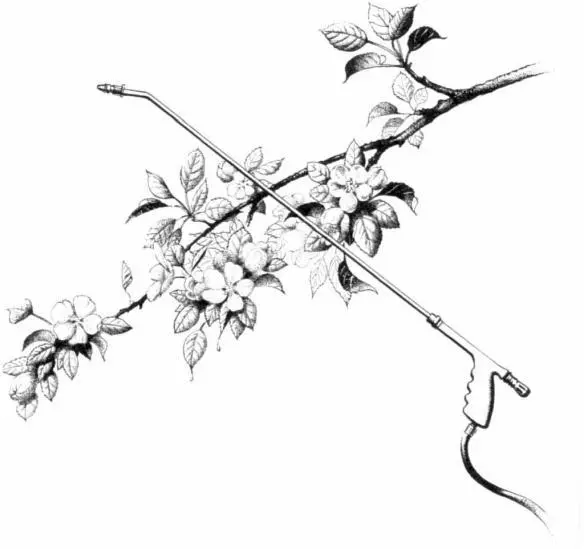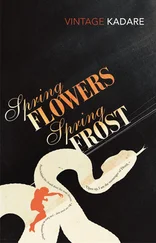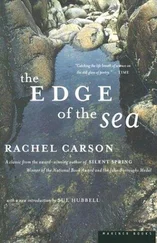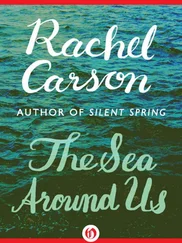
THERE WAS ONCE a town in the heart of America where all life seemed to live in harmony with its surroundings. The town lay in the midst of a checkerboard of prosperous farms, with fields of grain and hillsides of orchards where, in spring, white clouds of bloom drifted above the green fields. In autumn, oak and maple and birch set up a blaze of color that flamed and flickered across a backdrop of pines. Then foxes barked in the hills and deer silently crossed the fields, half hidden in the mists of the fall mornings.
Along the roads, laurel, viburnum and alder, great ferns and wildflowers delighted the traveler’s eye through much of the year. Even in winter the roadsides were places of beauty, where countless birds came to feed on the berries and on the seed heads of the dried weeds rising above the snow. The countryside was, in fact, famous for the abundance and variety of its bird life, and when the flood of migrants was pouring through in spring and fall people traveled from great distances to observe them. Others came to fish the streams, which flowed clear and cold out of the hills and contained shady pools where trout lay. So it had been from the days many years ago when the first settlers raised their houses, sank their wells, and built their barns.
Then a strange blight crept over the area and everything began to change. Some evil spell had settled on the community: mysterious maladies swept the flocks of chickens; the cattle and sheep sickened and died. Everywhere was a shadow of death. The farmers spoke of much illness among their families. In the town the doctors had become more and more puzzled by new kinds of sickness appearing among their patients. There had been several sudden and unexplained deaths, not only among adults but even among children, who would be stricken suddenly while at play and die within a few hours.
There was a strange stillness. The birds, for example—where had they gone? Many people spoke of them, puzzled and disturbed. The feeding stations in the backyards were deserted. The few birds seen anywhere were moribund; they trembled violently and could not fly. It was a spring without voices. On the mornings that had once throbbed with the dawn chorus of robins, catbirds, doves, jays, wrens, and scores of other bird voices there was now no sound; only silence lay over the fields and woods and marsh.
On the farms the hens brooded, but no chicks hatched. The farmers complained that they were unable to raise any pigs—the litters were small and the young survived only a few days. The apple trees were coming into bloom but no bees droned among the blossoms, so there was no pollination and there would be no fruit.
The roadsides, once so attractive, were now lined with browned and withered vegetation as though swept by fire. These, too, were silent, deserted by all living things. Even the streams were now lifeless. Anglers no longer visited them, for all the fish had died.
In the gutters under the eaves and between the shingles of the roofs, a white granular powder still showed a few patches; some weeks before it had fallen like snow upon the roofs and the lawns, the fields and streams.
No witchcraft, no enemy action had silenced the rebirth of new life in this stricken world. The people had done it themselves.
This town does not actually exist, but it might easily have a thousand counterparts in America or elsewhere in the world. I know of no community that has experienced all the misfortunes I describe. Yet every one of these disasters has actually happened somewhere, and many real communities have already suffered a substantial number of them. A grim specter has crept upon us almost unnoticed, and this imagined tragedy may easily become a stark reality we all shall know.
What has already silenced the voices of spring in countless towns in America? This book is an attempt to explain.
2. The Obligation to Endure

THE HISTORY OF LIFE on earth has been a history of interaction between living things and their surroundings. To a large extent, the physical form and the habits of the earth’s vegetation and its animal life have been molded by the environment. Considering the whole span of earthly time, the opposite effect, in which life actually modifies its surroundings, has been relatively slight. Only within the moment of time represented by the present century has one species—man—acquired significant power to alter the nature of his world.
During the past quarter century this power has not only increased to one of disturbing magnitude but it has changed in character. The most alarming of all man’s assaults upon the environment is the contamination of air, earth, rivers, and sea with dangerous and even lethal materials. This pollution is for the most part irrecoverable; the chain of evil it initiates not only in the world that must support life but in living tissues is for the most part irreversible. In this now universal contamination of the environment, chemicals are the sinister and little-recognized partners of radiation in changing the very nature of the world—the very nature of its life. Strontium 90, re-leased through nuclear explosions into the air, comes to earth in rain or drifts down as fallout, lodges in soil, enters into the grass or corn or wheat grown there, and in time takes up its abode in the bones of a human being, there to remain until his death. Similarly, chemicals sprayed on croplands or forests or gardens lie long in soil, entering into living organisms, passing from one to another in a chain of poisoning and death. Or they pass mysteriously by underground streams until they emerge and, through the alchemy of air and sunlight, combine into new forms that kill vegetation, sicken cattle, and work unknown harm on those who drink from once pure wells. As Albert Schweitzer has said, “Man can hardly even recognize the devils of his own creation.”
It took hundreds of millions of years to produce the life that now inhabits the earth—eons of time in which that developing and evolving and diversifying life reached a state of adjustment and balance with its surroundings. The environment, rigorously shaping and directing the life it supported, contained elements that were hostile as well as supporting. Certain rocks gave out dangerous radiation; even within the light of the sun, from which all life draws its energy, there were short-wave radiations with power to injure. Given time—time not in years but in millennia—life adjusts, and a balance has been reached. For time is the essential ingredient; but in the modern world there is no time.
The rapidity of change and the speed with which new situations are created follow the impetuous and heedless pace of man rather than the deliberate pace of nature. Radiation is no longer merely the background radiation of rocks, the bombardment of cosmic rays, the ultraviolet of the sun that have existed before there was any life on earth; radiation is now the unnatural creation of man’s tampering with the atom. The chemicals to which life is asked to make its adjustment are no longer merely the calcium and silica and copper and all the rest of the minerals washed out of the rocks and carried in rivers to the sea; they are the synthetic creations of man’s inventive mind, brewed in his laboratories, and having no counterparts in nature.
To adjust to these chemicals would require time on the scale that is nature’s; it would require not merely the years of a man’s life but the life of generations. And even this, were it by some miracle possible, would be futile, for the new chemicals come from our laboratories in an endless stream; almost five hundred annually find their way into actual use in the United States alone. The figure is staggering and its implications are not easily grasped—500 new chemicals to which the bodies of men and animals are required somehow to adapt each year, chemicals totally outside the limits of biologic experience.
Читать дальше














